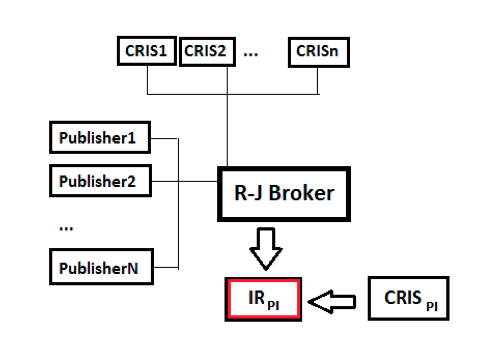Proposed deposit uptake monitor
This use case outlines potential user requirements and technical development considerations for a proposed deposit uptake monitoring tool, designed to track deposit rates of research publications into Institutional Repositories (IRs). This proposed tool would be designed to distinguish between automated and manual deposit procedures, with capability of reporting the rate of manually ingested deposits by authors or supporting services versus the rate of automated (RJ Broker) deposits via machine-to-machine transfers.
Description
As soon as the Repository Junction Broker (RJ Broker), a RepNet Wave 1 component, comes into service, the rate of item deposit into Institutional Repositories (IRs) is expected to increase substantially as a result. Other strategies for interoperability-based automatic content ingestion into IRs (such as those arising from the projects funded by the JISC Deposit Strand) will contribute to this uptake in deposit rates into IRs. This use case aims to provide a tool that enables monitoring of this expected increase in deposit rates, with the additional capability of reporting the rate of manually ingested deposits by authors or supporting services versus the rate of automatic deposits.
Since there are plans for including OA flavour of any particular deposit in the RIO Extension Guidelines for metadata enhancement, this proposed Deposit Uptake Monitor could easily become a useful tool as well for identifying the prevailing trends in Open Access practice, such as the balance between Green and Gold OA deposits and the degree of progress towards the goal of Gold OA becoming the default standard. This proposed development would be especially dependent on the V4OA Project to standardise access-level semantics.
Dependencies
- The RJ Broker plus other automatic deposit procedures
- RIO Extension Guidelines for Metadata Enhancement
- Vocabulary for Open Access (V4OA) Project
Data dependencies
Contents automatically deposited into IRs as a result of RJ Broker transfers (or CRIS-pushed) will become appropriatedly tagged along the process. Automatic vs manual deposited record count will thus be easily monitored since every RJ Broker service launches in a mixed manual / automatic fashion. RepNet is currently checking (see RepNet survey for IR managers) mostly manual procedures for tracking deposit increase currently in use by IR managers in order to harmonise them and complete them with an automated way of tracking automatic RJ Broker- or CRIS-mediated deposits.
Usefulness
This proposed Deposit Uptake Monitor will be of use for measuring the impact of the procedures for automatic content deposit into IRs, thus providing evidence base for the JISC and Deposit Projects (including RepNet) that JISC has funded. It will also enable IR managers to accurately account for content increases resulting from interoperability-driven strategies for populating IRs, and it is expected to enable institutions to track and report the evolution of their their Green/Gold OA publication balance. Finally, this proposed Deposit Uptake Monitor will provide cross-repository guidelines for harmonisation of deposit count procedures.
The app value will be measured by its ability to collect and display a deposit uptake monitoring across the whole repository network. Data for this global picture is planned to be collected for every single IR as a way of allowing all repositories to showcase their own growth rates and provide a benchmarking tool, but this could also potentially be extracted from metadata aggregation if the required tagging procedures were followed.
Feasibility
The Deposit Uptake Monitor feasibility relies very much on harmonisation of the automatic assignment of metadata field values by automatic depositing services such as RJ Broker or CRIS /I R transfer . Once that is accomplished, the feature specification process should be quite straightforward. (Note: Repnet expects to be able to have a metadata subfield allocated for this purpose within the RIOXX applications profile.)
RepNet is aware that other initiatives are at work on this specific reporting strand and is willing to jointly work with these other initiatives in order to take in potentially useful suggestions for the service.
- Log in to post comments

